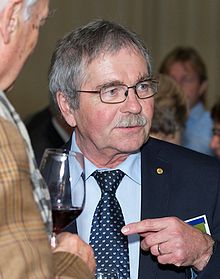Johannes Georg Bednorz
| Johannes Georg Bednorz | |
|---|---|

Bednorz in 2013
|
|
| Born |
16 May 1950 Neuenkirchen, North Rhine-Westphalia, Germany |
| Nationality | German |
| Fields | Physics |
| Doctoral advisor | Heini Gränicher, K. Alex Müller |
| Known for | High-temperature superconductivity |
| Notable awards |
Marcel Benoist Prize (1986) Nobel Prize in Physics (1987) |
Johannes Georg Bednorz (born 16 May 1950) is a German physicist who, together with K. Alex Müller, discovered high-temperature superconductivity in ceramics, for which they shared the 1987 Nobel Prize in Physics.
Bednorz was born in Neuenkirchen, North Rhine-Westphalia, Germany to elementary-school teacher Anton and piano teacher Elisabeth Bednorz, as the youngest of four children. His parents were both from Silesia in Central Europe, but were forced to move westwards in turbulences of World War II.
As a child, his parents tried to get him interested in classical music, but he was more practically inclined preferring to work on motorcycles and cars. (Although as a teenager he did eventually learn to play the violin and trumpet.) In high school he developed an interest in the natural sciences, focusing on chemistry, which he could learn in a hands-on manner through experiments.
In 1968, Bednorz enrolled at the University of Münster to study chemistry. However, he soon felt lost in the large body of students and opt to switch to the much less popular subject of crystallography, a subfield of mineralogy at the interface of chemistry and physics. In 1972, his teachers Wolfgang Hoffmann and Horst Böhm arranged for him to spend the summer at the IBM Zurich Research Laboratory as a visiting student. The experience here would shape his further career, not only did he meet his later collaborator K. Alex Müller, the head of the physics department, but he also experienced the atmosphere of creativity and freedom cultivated at the IBM lab which he credits as a strong influence on his way of conducting science.
...
Wikipedia
